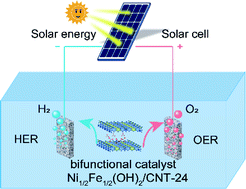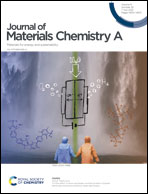Controllable atomic defect engineering in layered NixFe1−x(OH)2 nanosheets for electrochemical overall water splitting†
Abstract
Exploring efficient electrocatalysts through controllable defect engineering in materials with low-cost and earth-abundant elements is highly desired for overall water splitting. Herein, a hybrid electrocatalyst was successfully prepared by growing layered α-phase NiFe hydroxide on mildly oxidized carbon nanotubes (NixFe1−x(OH)2/CNT) through a hydrothermal process. Then, NixFe1−x(OH)2/CNT hybrids with defect structures accompanied by a change from Fe(OH)2 to α-FeOOH were prepared via in situ oxidation of Fe(OH)2 with H2O2 solution. In situ Raman spectroscopy was employed to investigate the change of the electrocatalysts under different potentials and identify the active sites in the oxygen evolution reaction (OER) process. In addition, X-ray absorption fine structure (XAFS) spectroscopy was employed to probe the metal defects in the hybrid. The outstanding electrocatalytic efficiency of Ni1/2Fe1/2(OH)2/CNT with defects was accessible with a remarkably small overpotential of 244 mV and Tafel slope of 41 mV per decade for the OER in a 1.0 M KOH aqueous solution. Its bifunctional electrocatalytic efficiency was also evaluated using a two-electrode system, achieving a current density of 10 mA cm−2 at an applied voltage of 1.64 V by loading the electrocatalyst on nickel foam. Furthermore, the high solar-to-hydrogen conversion efficiency of ∼10.3% for the bifunctional electrocatalyst indicates that the introduction of defects into the catalyst can significantly improve its catalytic efficiency, making it a promising low-cost catalyst for overall water splitting.



 Please wait while we load your content...
Please wait while we load your content...